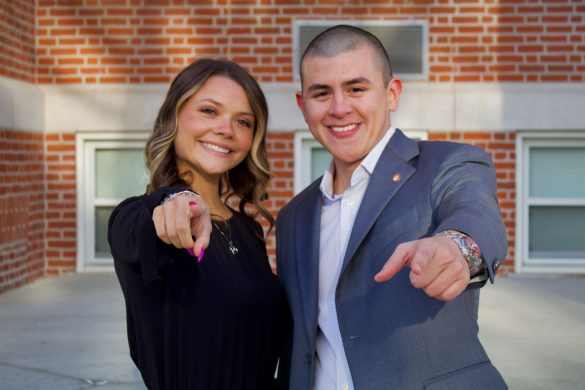Traditional housing usually involves two people sharing a space with two desks, two closets, two beds and two dressers. Some students on the the University of Indianapolis campus started this year with three of everything in their room or more. With UIndy’s largest freshman class on record, the university had to implement alternative housing solutions.
“Anytime the university is in what we call an overflow housing situation, meaning we don’t have capacity in a traditional room, two to a room or singles or whatever it may be,” said Vice President for Student Affairs and Dean of Students Kory Vitangeli. “What we have traditionally done is look for places on campus where we can accommodate overflow housing.”
Solutions can range from setting up triple rooms, transforming lounge spaces and pairing up resident assistants. Vitangeli said that these solutions are the typical responses and are the best way to keep students on campus.
“Some schools, they choose to go off campus to hotels, apartments or other things when they are in overflow,” Vitangeli said. “But we decided at that time that students were choosing to live on campus for a reason, because they wanted the convenience . . . It was important for us to look for ways to convenience people on campus, and that’s when we came up with these solutions.”

Students socialize and study in the lounge area of the lobby of Warren Hall. This year’s freshman class is the largest on record to enter UIndy. Photo by Emanuel Cela
Cory Bretz Hall has had to implement many of these housing solutions to accommodate the large number of male students wanting to live on campus. According to Residence Director for Cory Bretz Carrington Clodius, 15 of her male RAs started the school year with roommates.
“This is the first year I’ve encountered having additional housing [in my hall],” Clodius said. “And we pretty much got the heads up over the summer, way before the students came, so we could start planning to have bigger numbers and just to have students in the building and possible alternative housing everything.”
Clodius is down to 10 paired RAs but still has to facilitate the relationships between students inhabiting the lounge spaces on each floor. These overflow spaces are set up just like traditional rooms and, in Cory Bretz, are usually larger than some traditional rooms.
“It’s still a residence hall room with furniture; everybody still gets a desk, a bed, a dresser, a closet,” Vitangeli said. “And a lot of times when we go to move people out of those temporary housing locations, they don’t want to move because they are settled.”
Indications for the need for overflow housing arose during the summer, according to Housing Assignment Coordinator Mary Craft. Craft said that roommate assignments for the underclassman dorms are picked in late June or early July and mailed to students by mid-July.
“It is kind of tricky; we do our placements in beginning of July,” Craft said. “We send out letters in the middle of July. There are some students that get a letter saying pending, and that means we weren’t able to place them. And when we are able to place them, we are able to send them a letter or give them a call and explain to them that they have been placed and who their roommate is.”
According to Craft, placement depends on when students turn in their housing deposit. Craft uses housing deposit numbers to make a priority list of who to place and when overflow solutions must be implemented.
“This year, it’s actually good that we haven’t had that many withdrawals and that is actually a good thing,” Craft said. “This is a good problem to have-that we have this many students on campus-because we want our students on campus. We think that is a good thing. It is good opportunity and we haven’t had too many situations where they [the students] were absolutely miserable. Most people were okay.”
Vitangeli said her goal is to keep as many upperclassmen on campus as possible.
According to Vitangeil, this large number of older students has caused additional solutions to be implemented. During upperclassman sign up on campus, students were offered the opportunity to buy out rooms in all dorms.
“There’s not a huge desire for upperclassmen to go back into Warren, Cravens and Cory Bretz,” Vitangeli said. “They’ve had that for their freshman and sophomore years, and they are looking for a different experience their junior and senior years. It really was a try to keep a lot of those sophomores on campus.”
According to Craft, housing will reserve a certain number of freshman spaces and having the buyouts did not affect the total number of rooms available. Students who currently live in overflow spaces are given a $500 credit, and RAs with roommates are also compensated.
Even though these solutions are not ideal, Clodius said she would not want to change the dynamic of her hall.
“The biggest thing is that it just feels like a family,” she said. “I really enjoyed it this year, just having so many residents. And if you asked any of the RAs, they wouldn’t want to give up any of their extra people. Some of the students that are in the alternative housing that came kind of of last minute, they have been some of the biggest personalities in the hall. It’s been really nice.”








